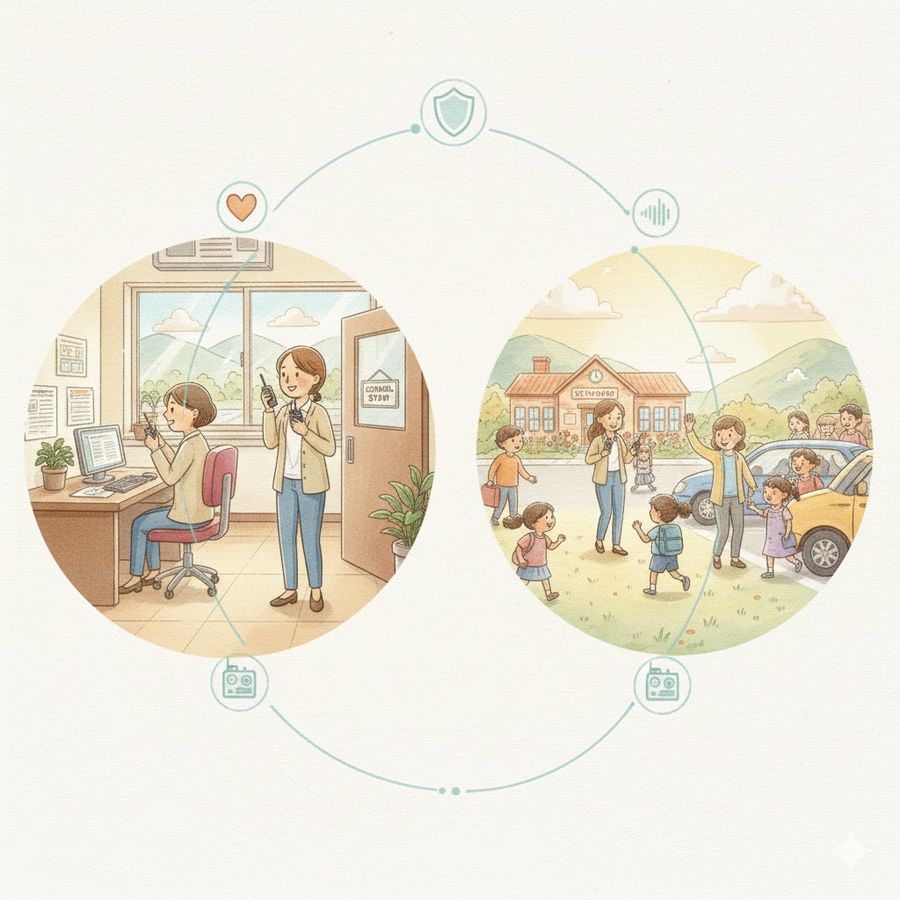
Improving School Safety With Reliable Radio Communication
On this page
- Why two-way radios are essential for school safety
- Core safety outcomes radios improve on campus
- Coverage fundamentals for schools
- Analog or digital (DMR) for schools?
- A simple, durable channel/talkgroup plan
- Daily operations where radios shine
- Accessories that boost clarity and safety
- Training that works under stress
- Incident command on a school campus
- Integration without overcomplication
- Implementation roadmap (copy/paste for your project plan)
- Maintenance that keeps systems reliable
- Metrics that prove impact
- Common pitfalls (and how to avoid them)
- Sample procedures you can copy
Keeping students and staff safe boils down to seconds—how quickly the right adults hear the right message and act. Phones and apps are great for individual messaging, but they aren’t built for urgent, one-to-many coordination. Two-way radios are. With a press of the PTT, principals, office staff, security, nurses, and custodians can act in sync—during daily routines and the rare crisis alike.
This guide shows K-12 leaders how to design, deploy, and maintain a school radio program that delivers clear coverage, simple talkpaths, and confident communication under stress. You’ll get step-by-step planning advice, role-based channel layouts, accessory recommendations, training drills, and practical FAQs you can share with your team.
Why two-way radios are essential for school safety
- Instant group voice: Press-to-talk connects a team or the whole campus in under a second—no dialing, ringing, or app lag.
- Independent of public networks: Radios keep working when cellular and Wi-Fi are congested or offline.
- Role-based control: Channels (analog) or talkgroups (digital) make sure operations, security, health, and admin hear the right traffic without chatter.
- Simple under stress: Big buttons, glove-friendly knobs, loud speakers, and intuitive operation support clear action when adrenaline spikes.
- Durable and long-running: Batteries last the full school day; housings withstand rain, dust, and drops.

Core safety outcomes radios improve on campus
- Faster incident response: Medical, behavioral, and facilities issues reach the right adults immediately.
- Coordinated movement: Arrival, lunch, recess, assemblies, and dismissal run with fewer bottlenecks.
- Crisp incident command: Clear roles and a dedicated emergency channel reduce confusion during drills and real events.
- Better coverage in hard spaces: With proper engineering, radios reach stairwells, gyms, auditoriums, and portables where phones often fail.
- Staff privacy: Radios avoid sharing personal phone numbers and support discreet earpieces where appropriate.
Coverage fundamentals for schools
Choose the right band for buildings
Most K-12 campuses benefit from UHF because it generally penetrates classrooms, hallways, low-E glass, and steel better than VHF. If your district includes large athletic fields or rural bus routes, you can still keep UHF for the building footprint and cover fields with a well-placed antenna or repeater.
Height beats watts
Raising the base or repeater antenna above parapets and rooftop clutter improves coverage more than simply adding power. Place antennas high and central, use low-loss coax, and weatherproof every connector. Small tweaks here often remove “dead rooms” and stairwell dropouts.
Fix stubborn areas surgically
Some spaces—music rooms, gyms with steel truss, stair towers, tunnels—need targeted help:
- Distributed Antenna System (DAS): Ceiling antennas and splitters that bring RF into deep interiors.
- Leaky feeder: Radiating cable along stairwells or long corridors that won’t behave.
- Temporary drops: Add a discreet indoor antenna near auditoriums or additions undergoing renovation.
Analog or digital (DMR) for schools?
Analog works, is simple to train, and pairs well with small fleets. Digital (DMR) adds benefits that matter for busy campuses:
- Two time slots on one repeater channel for more capacity at bell times and events.
- Cleaner audio at weak signal so words remain intelligible in marginal spots.
- Talkgroups that mirror roles (Admin, Security, Facilities, Health, Transport) without creating channel sprawl.
- Unit IDs, emergency/man-down, text, GPS (optional) for supervision and dispatch.
If you hear stepped-on calls or “please clear the channel,” DMR capacity is usually the fastest fix.
A simple, durable channel/talkgroup plan
Keep it short and consistent across all radios. Name things plainly so no one hesitates.
- SITE — Time-sensitive campus announcements and movement.
- ADMIN — Principals, APs, front office, deans.
- SECURITY — Campus security and SROs.
- FACIL — Custodial and maintenance.
- HEALTH — Nurse and designated responders.
- TRANSPORT — Bus dispatch, arrival/dismissal checkpoints (as needed).
- EMERG — Emergency/incident command channel, monitored by designated leaders; kept clear unless needed.
If using DMR, map each to a talkgroup and keep scan lists minimal (home + SITE). Over-scanning causes missed syllables.
Daily operations where radios shine
Arrival and dismissal
Coordinate traffic, buses, crosswalks, and door coverage. A single call from the office updates all monitors, while admins can shift staff when a bus is delayed or weather changes.
Classroom support and facilities
Teachers radio the office for coverage, custodial cleanup, or a quick temp check. Facilities redirect techs to the nearest urgent task without tying up phones.
Visitor management
Front office notifies Security and the receiving staff instantly; discreet earpieces keep conversations private in lobbies and halls.
Medical and behavioral response
The moment help is needed, the nurse, admin, and the nearest trained adult coordinate care and room movement—no hunting for numbers.
Events, drills, and athletics
Assemblies, games, and reunification exercises require synchronized movement. Radios keep FOH, crowd control, and medical aligned even in noisy venues.
Accessories that boost clarity and safety
- Remote Speaker Microphones (RSMs): Keep the mic at 1–2 inches from the mouth for consistent intelligibility in noise and during recess or traffic duty.
- Discreet earpieces: Front office, administration, and security can hear clearly without disrupting classes or revealing sensitive details.
- Headsets for high-noise zones: Gym, shop class, and events benefit from noise reduction and hands-free operation.
- Multi-unit chargers: Place 6-bank chargers in the office, security room, nurse’s office, and custodial shop for easy rotation.
- IP-rated, compact portables: Prefer IP67 where rain and frequent sanitizing are realities.
Training that works under stress
PTT technique
Teach “press, pause, speak”: press the PTT, pause one second for the channel to open, then speak clearly 1–2 inches from the mic. This prevents clipped words.
Plain language beats codes
Use short, clear, location-first phrases: “Nurse to Gym A—student ankle injury.” Codes fail when people are stressed or when substitutes are on duty.
Channel discipline
Keep SITE and EMERG free of chatter. Move extended coordination to role channels. Use quick acknowledgments (“Copy—Admin en route”) to avoid duplicates.
Five-minute monthly mini-drills
Practice one scenario a month: medical assist, missing student protocol, weather shelter, facility hazard, or reunification. The habit matters more than complexity.
Incident command on a school campus
You don’t need a thick manual—just clear roles, channels, and phrases.
- Incident Commander (IC): Principal or designee; monitors EMERG, can temporarily control SITE.
- Operations: Movement of people—evacuation, shelter, reunification.
- Communications: Keeps radio plan on track, assigns talkpaths, and protects SITE from chatter.
- Medical: Nurse and trained responders; coordinates triage and EMS arrival.
- Liaison: Coordinates with district leadership and first responders.
Print a one-page card for each role with primary/backup channels and phrase templates (“All-call: Shelter in place. Secure doors. Await instructions.”).
Integration without overcomplication
- PA/Radio link: Some sites link a base radio to PA zones for all-call. Keep scripts simple and test monthly.
- Gate controls and sensors: Avoid cluttering the air with automation; radios are for human coordination.
- Buses and dispatch: A base at dispatch plus roof-center quarter-wave antennae on buses improve transport comms during arrival and field trips.
Implementation roadmap (copy/paste for your project plan)
- Walk the campus: Mark stairwells, basements, gyms, auditoriums, portables, and known weak spots.
- Pick band & pilot: Start with UHF; conduct a 30–60 minute walk test with borrowed radios.
- Decide analog vs. DMR: If more than two busy groups overlap or you’ve had stepped-on calls, choose DMR for two time slots and talkgroups.
- Place the antenna/repeater: High, central, clear; use low-loss coax and weatherproof all connections.
- Define talkpaths: SITE, ADMIN, SECURITY, FACIL, HEALTH, (TRANSPORT if needed), EMERG. Keep names short.
- Standardize accessories: RSMs for yard/security; earpieces for office/admin; multi-bank chargers strategically placed.
- Train in 10 minutes: PTT technique, channel plan, SITE/EMERG etiquette, emergency phrases.
- Run a mini-drill: One five-minute scenario per month. Record takeaways.
- Maintain quarterly: Inspect antennas, cords, and connectors; reflash from the master codeplug; date-label batteries and replace on schedule.
- Document: Keep a communications binder with license grant, channel plan, codeplug version, and vendor contacts.
Maintenance that keeps systems reliable
- Battery lifecycle: Date-label every pack; replace on an 18–30 month cycle depending on duty.
- Hardware checks: Quarterly inspection of antennas and RSM cords; replace bent or cracked parts.
- Programming discipline: Maintain a versioned “golden codeplug”; lock menus to prevent drift.
- Rooftop integrity: After any roof work, re-weatherproof and re-verify coverage. Water ingress and corrosion create elusive failures.
Metrics that prove impact
- Nurse response time: From call to on-scene arrival.
- Dismissal duration: From bell to last car or bus cleared.
- Incident resolution time: From call to back-to-class status.
- Coverage confirmations: Percentage of marked weak spots improved after antenna placement and training.
- Drill compliance: Participation and completion times for monthly mini-drills.
Common pitfalls (and how to avoid them)
- Too many channels: Confusion rises and response slows. Keep the plan short.
- Long scan lists: Users miss the first words while the radio listens elsewhere. Limit to home + SITE.
- Chasing watts: Height and placement beat raw power—especially indoors.
- Skipping training: A five-minute refresher prevents hours of repeated calls.
- Radios in drawers: Radios must be worn and used to help. Build habits with check-out/check-in and quick drills.
Sample procedures you can copy
Shelter in place
- IC moves to EMERG; Communications protects SITE.
- Admin issues a plain-language all-call over PA and radio.
- Security checks exteriors and reports by area.
- Teachers confirm room status if directed; keep radios quiet otherwise.
- Liaison updates district/first responders as needed.
Medical assist
- Staff: “Nurse to Gym A—student fall, responsive.”
- Nurse acknowledges, requests supplies or additional staff.
- Admin or security routes foot traffic and opens paths.
- After action: note lessons; update quick-reference cards.
On this page
- Why two-way radios are essential for school safety
- Core safety outcomes radios improve on campus
- Coverage fundamentals for schools
- Analog or digital (DMR) for schools?
- A simple, durable channel/talkgroup plan
- Daily operations where radios shine
- Accessories that boost clarity and safety
- Training that works under stress
- Incident command on a school campus
- Integration without overcomplication
- Implementation roadmap (copy/paste for your project plan)
- Maintenance that keeps systems reliable
- Metrics that prove impact
- Common pitfalls (and how to avoid them)
- Sample procedures you can copy